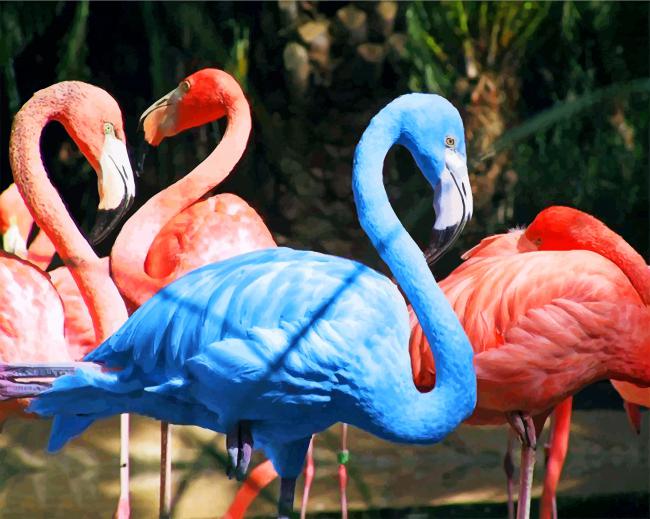Have you ever wondered how flamingos get their vibrant pink color? You might have even asked yourself, do they start out white and turn pink as they grow older? While this idea might seem plausible, it’s actually not quite right. The story of a flamingo’s color is more complex and fascinating than you might think.

Image: animal-club.co.uk
The truth is that flamingos aren’t born pink. They actually hatch with a greyish-white plumage. Their signature pink hue is a fascinating product of their diet and a unique relationship with the food they consume. This phenomenon is a testament to the amazing adaptation and survival strategies of nature, making it a captivating topic for anyone interested in the natural world.
From Grey to Pink: The Journey of a Flamingo’s Color
The Secret Ingredient: Carotenoids
The key to understanding a flamingo’s color transformation lies in a class of pigments called carotenoids. You might recognize carotenoids from their role in giving carrots their vibrant orange hue, but they’re also found in a variety of other fruits, vegetables, and plants. These pigments are essential for a flamingo’s survival, acting as powerful antioxidants that protect their cells from damage.
From Food to Feathers: The Absorption and Deposition Process
Flamingos obtain these essential carotenoids through their diet, primarily from the brine shrimp and algae they consume. These tiny creatures are rich in carotenoids, particularly astaxanthin, a pigment that gives salmon its pink color. These carotenoids are then absorbed into the flamingo’s bloodstream and deposited into their feathers, skin, and beak, giving them their characteristic pink color.
Interestingly, flamingos don’t actually produce carotenoids themselves. They rely on obtaining them from their diet. This means that their color is directly linked to the food they eat. If a flamingo were to be deprived of its diet of brine shrimp and algae, its feathers would gradually lose their pink color and become a more dull white or even grayish.

Image: thepopularflamingo.com
The Shades of Pink: A Spectrum of Color
The intensity of a flamingo’s pink color can vary depending on several factors. These factors include:
- Diet: The availability of carotenoid-rich food sources can directly impact a flamingo’s coloration. Flamingos that have access to abundant amounts of brine shrimp and algae will have brighter pink feathers.
- Age: Younger flamingos often have a less vibrant pink hue than older ones. The longer they feed on a carotenoid-rich diet, the more concentrated the pigment becomes in their feathers, resulting in a deeper shade of pink.
- Species: Different species of flamingos have variations in their natural pigmentation. Some species may have a more intense pink hue than others.
- Location: Geographic variations in the availability of food and other environmental factors can lead to subtle differences in the shade of pink among flamingo populations.
Beyond Pink: The Fascinating World of Carotenoids
Carotenoids are not just important for a flamingo’s color, they also play a critical role in their overall health. These pigments act as antioxidants, which protect the body from damage caused by free radicals. This is particularly important for flamingos, which face harsh environmental conditions and potential exposure to toxins.
Carotenoids also play a role in a flamingo’s courtship rituals. The brighter and more intense the pink color of a flamingo’s feathers, the more attractive it is to potential mates. This suggests that the vibrant color is not only a result of diet but can also serve as a visual cue of health and vitality, enhancing a flamingo’s chances of reproduction.
A Colorful Tale of Adaptation
The story of a flamingo’s color is more than just a fascinating quirk of nature. It’s a testament to their unique adaptation to their environment. By consuming carotenoid-rich food sources, flamingos not only obtain essential nutrients but also develop a vibrant color that plays a vital role in their survival and reproduction.
Do Flamingos Lose Their Color After Birth
From Grey to Pink: A Journey Worth Exploring
The next time you see a flamingo, take a moment to appreciate the colorful journey behind its appearance. Their vibrant pink hue isn’t a result of genetics but rather a testament to the intricate relationship between diet, adaptation, and survival. Understanding this connection can inspire us to explore the fascinating world of nature, unraveling the captivating stories hidden within the colors and patterns of our planet’s diverse creatures.

:max_bytes(150000):strip_icc()/OrangeGloEverydayHardwoodFloorCleaner22oz-5a95a4dd04d1cf0037cbd59c.jpeg?w=740&resize=740,414&ssl=1)




